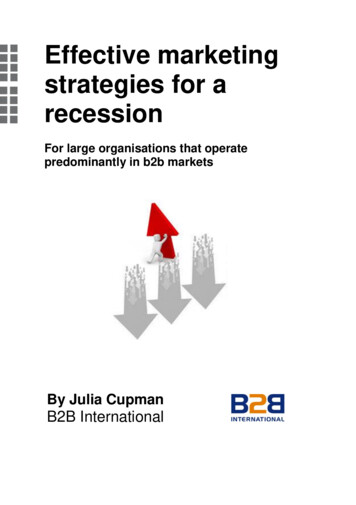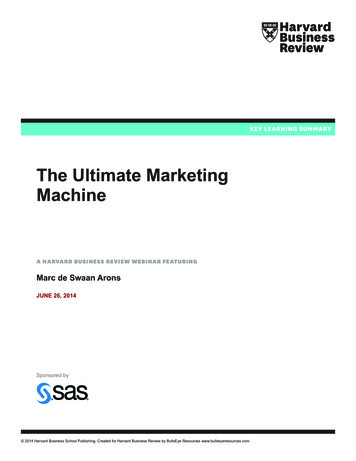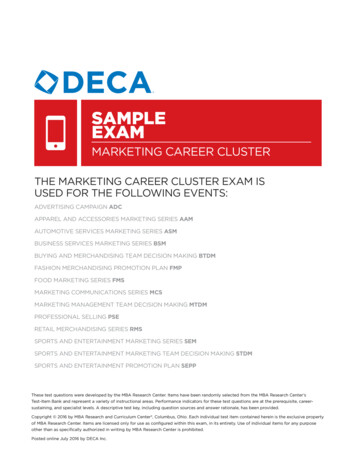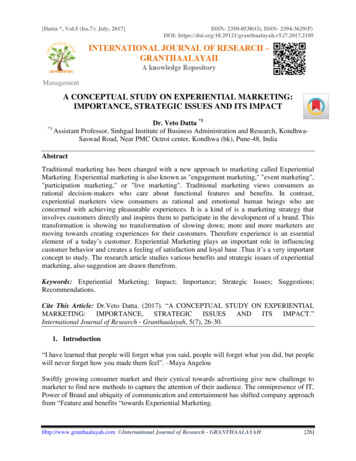
Transcription
Effective marketingstrategies for arecessionFor large organisations that operatepredominantly in b2b marketsBy Julia CupmanB2B International
AbstractWhilst the principles of marketing stay the same regardless of theprevailing economic environment, it is the practice of marketingthat changes, especially in a recession. In response to the slumpin demand and decreased sales, many marketing teams have hadtheir budgets slashed and their resources cut back. Thesechallenges, along with volatility in the marketplace and constantlychanging customer needs, mean it is difficult for marketers todetermine what marketing strategies to employ.There are a plethora of factors that influence the appropriatenessof a certain marketing strategy for a particular company, includingthe overall objective of the strategy, the level of available humanand financial resources to implement the strategy, the geographicalscope being considered and the elasticity of demand in themarketplace, to name but a few examples. Common to allstrategies is that some kind of payback is required, in that everystrategy should seek to provide a return on investment.This paper explores strategic reactions to a recession andexamines the findings from a survey of 310 marketingprofessionals who work in b2b corporates across the world.Various marketing strategies are discussed, with a particular focuson what makes a strategy effective in turbulent times.Page 2
Effective marketing strategies for a recessionContents1. Introduction . 42. The role of marketing strategy . 73. Common reactions to a recession . 10Inertia . 10Lowering prices . 10Cutting costs . 124. Effective marketing strategies for a recession. 14Effective pricing strategies . 14Effective strategies in the context of Ansoff – determiningwhich products and which markets . 20Summary . 265. Survey on marketing in the recession . 27About the survey . 27Effects of the recession . 27The economic outlook . 30Attitudes to marketing in a recession . 31Marketing challenges in a recession . 32Strategic responses to the recession . 35Changes to the marketing toolkit. 38Evaluating marketing strategies in the recession . 396. Conclusions . 42Key changes to marketing in a recession . 42Effective marketing strategies for a recession . 457. References . 50Page 3
“A time of turbulence is a dangerous time, but its greatest dangeris a temptation to deny reality [However] a time of turbulence is also one great opportunity forthose who can understand, accept and exploit the new realities. Itis above all a time of opportunity for leadership” (Drucker, 1980)1. IntroductionIn Europe, a widely acknowledged definition of a recession is thereduction of a country‟s gross domestic product (GDP) for at leasttwo quarters. In the US, the definition of economic recession issomewhat looser: "a significant decline in economic activity spreadacross the economy, lasting more than a few months, normallyvisible in real GDP growth, real personal income, employment(non-farm payrolls), industrial production, and wholesale-retail1sales." Whatever the definition, there can be no doubt that muchof Europe and the US have slipped into a recession.In virtually all markets, demand has shrunk, there is immensepressure on suppliers to reduce prices, markets are more focusedon buying on price, and profit margins are squeezed. The fear ofdownfall as a result of recessionary pressures has led, andcontinues to lead, to a fierce slashing of budgets, in particularmarketing budgets. For instance, Marks & Spencer has reduced1According to The National Bureau of Economic Research, BusinessthCycle Expansions and Contractions, 19 November 2008Page 4
Effective marketing strategies for a recessionthits marketing budget by 20% (Marketing Magazine, 7 January22009) and FedEx has cut its marketing budgets by more than 25%th3(Reuters, 7 January 2009) . Why are marketers feeling the pinchwith decreased spending power when it is such a crucial time tounderstand customers‟ requirements and meet their needs beforethey could potentially defect? Given that most businesses losearound half of their customers every five years, it is frightening tothink how many customers have been lost in the past few monthsalone as a result of the faltering economy.This is particularly worrying for companies that operate in b2bmarkets, for b2b companies have far fewer customers than b2ccompanies and in general tend to have strong relationships withtheir customers, especially their largest customers. According tothe Pareto principle, these largest customers comprise 20% of allcustomers served by a b2b company and yet account for 80% ofturnover. In a recession, a b2b company is thus highly dependenton this small clutch of valuable customers and is significantlyaffected if any of these customers goes bust or cuts demand. Forobvious reasons, b2b companies need to work hard on keepingtheir existing customers during a recession and, of course, onfinding new ones.Marketing is a means of identifying and meeting needs profitablyand it plays an instrumental role in retaining existing customers, aswell as in attracting and winning new ones. The most profitablecompanies in a recession are typically those that delineate andexecute marketing strategies successfully, but determining whichmarketing strategy to adopt is not an easy task. Apart from doingnothing at all, the worst that companies can do is presume that theonly way forward is to slash prices, for in doing so they are possiblyneglecting the other vital elements of the marketing mix, potentiallytarnishing their brand image and underestimating the importance ofmeeting customer needs.Tighter economic conditions sharpen the focus of business andmarketing strategies. Strong economies allow many companiesthe luxury of indulgence and a profitable bottom line cansometimes be achieved in spite of their (in)actions. Furthermore,23For 2009For 2009Page 5
in buoyant conditions, companies may be able to achieve levels ofprofitability which delude them into believing that their strategiesare working and yet they may never know that they could be muchmore profitable had they adopted a different strategy. In arecession, the smallest of strategic mistakes could, however, resultin a company failing quickly. The right marketing strategiestherefore act as insurance against risk, making companies lessvulnerable to the vicissitudes and volatility of the business andeconomic environment, as well as act as an aggressive marketingtool that ensures survival and unleashes potential opportunities.As Harvard Business School Professor John Quelch recentlystated, “Successful companies do not abandon their marketingstrategies in a recession; they adapt them.” (Harvard BusinessrdSchool Working Knowledge, 3 March 2008).With this in mind, this paper explores what constitutes effectivemarketing strategies for a recession, with a particular focus oncompanies that operate in b2b markets. The paper covers two keyaims:1.To explore how organisations are reacting to the currentrecessionary pressures in terms of marketing strategiesthey have employed.2. To determine which marketing strategies can beconsidered the most effective for a recession.The next section discusses the role of marketing strategy, which isfollowed by a description of typical reactions to a recession andeffective marketing strategies that can be employed for tougheconomic times. This is then followed by an overview and analysisof the insights obtained through primary research, in which asurvey of marketing professionals explored their attitudes to therecession and how they are responding to it. The paper concludeswith a summary of key findings, as well as strategicrecommendations for companies that are reviewing their marketingstrategies in light of recessionary pressures.Page 6
Effective marketing strategies for a recession2. The role of marketing strategyA key strength of marketing in a corporation is that it can generatesymptomatic information (Samli, 1993 p50). That is, the marketingdepartment is capable of diagnosing a corporate problem longbefore the financial statements document the state of health of thecompany, at which point it could be too late to take correctiveaction. With the assistance of market research, marketers canidentify a company‟s strengths, weaknesses, opportunities andthreats prior to recessionary turbulence and enable the company toconsolidate its offering, to become increasingly competitive, and todevelop proactive marketing strategies that will enable it to surviveand prosper in times of adversity. Hence marketing plays a vitalrole in stimulating prosperity for the firm, as indicated in Figure 2.1.This input/output model illustrates that factors in the externalenvironment – which Samli (1991 p51) refers to as „externaluncontrollables‟ – direct the strategic planning of the company as itreviews its strategic options in light of the prevailing marketconditions and all external influences. Indicators and symptoms ofthe marketing impact then provide guidance on corrective actionsrequired on the marketing inputs (such as the firm‟s products,brands and sales force). Responding early to market indicatorsand symptoms can eliminate problems and strengthen acompany‟s resistance to recessionary turbulence when it occurs.Figure 2.1Modified Version Of Samli’s Input/OutputModel of Strategic OUTPUTINDICATORSSYMPTOMSPage 7MarketingimpactFirm‟sprosperity
The direction of strategic planning in the input/output modeldepends on the aim and objectives of the marketing strategy. Amarketing strategy can be defined as a means to an end, enablingmarketers to apply a process in order to achieve a profitableoutcome. It is likely to pursue one of the following goals: To banish or reduce problems, for example counteractingdeclining sales of a particular product or new competitorshaving entered the market; orTo strive for improvement, for example with more effectivemarketing communications or more effective packaging; orTo seek opportunities, for example through new marketentry or new product development.This may seem relatively straightforward. Indeed most people canrecognise weaknesses in a company and suggest a potentialstrategic resolution.But whilst corporate strategies are inabundance, only few strategies actually bear fruit. According to asurvey by the Economist Intelligence Unit, companies typicallyrealise only around 60% of their strategy‟s potential value due tofailures in planning and execution (Syrett, 2007 p11). Manystrategies fail due to corporate politics, undefined goals, a lack ofappropriate controls or changing circumstances, all of which resultin a distorted focus. Thus ensuring that a strategy is executedeffectively and with a maximum return on investment is achallenging task, which is made all the more challenging ineconomically turbulent times.Marketing strategies are not unique to the prevailing economicclimate. For instance pricing strategies, such as discounts andspecial offers to encourage customers to buy, are employed intimes of a booming as well as weak economy. Michael Porter(1980 p34) suggested that companies have three strategic options:to differentiate, to compete on cost, or to specialise in meeting theneeds of a niche. Igor Ansoff (1957 p113) argued that companiescan adopt one of four strategies – marketing existing products toexisting markets, marketing new products to existing markets,marketing existing products to new markets, and marketing newproducts to new markets, as illustrated in Figure 2.2. All of theseoptions can be adopted, irrespective of business conditions.Page 8
Effective marketing strategies for a recessionFigure 2.2Ansoff’s Four StrategiesNewproducts toexistingmarketsNewproducts tonew marketsExistingproducts toexistingmarketsExistingproducts tonew marketsHowever, a tightening of the economic environment may changethe game for many companies. A company that was comfortableselling its products locally may suddenly find that its market hasdried up. It may be forced to look wider afield and seek anotherAnsoff option. A company aiming at a niche, such as young citytraders, may find that the niche has disappeared and may need tolook elsewhere for its custom. Whatever challenges a companymay face, from defecting customers to decreasing profit margins, acoherent strategy is required to deal with these challenges, asopposed to meagre and piecemeal actions which many companiesconsider easier but which are rarely successful in the medium tolong term. This leads to the following chapters which explorecommon reactions to a recession, and effective marketingstrategies that not only counteract recessionary turbulence, butalso reap the benefits from it.Page 9
3. Common reactions to a recessionCompanies typically react to a recession in at least one of thefollowing ways: they attempt to carry on as normal (inertia); theylower prices; or they cut costs. Each of these reactions isdiscussed in turn below.InertiaSamli (1993, p1) argues that if firms behave in a reactive orinactive fashion in response to a recession, they are not seeking tocounteract market adversities and ultimately take a fatalistic pointof view of doing nothing. Such a passive approach to recessionarypressures is dangerous, for it displays indifference to volatilemarkets comprising customers that are more likely to switch tocompetitors with more attractive offerings.The contraction in demand is significant and sustained in arecession, meaning that for many companies it is simply notpossible to wait out the storm. Consequently most companies areforced to react in some way. Competitive pressures increasesubstantially in a downturn as revenues plummet and everyonefights to maintain or grow their customer base. The companiesthat ultimately cannot fight hard enough fail.Lowering pricesA collapse in demand can lead to price wars as markets are moreprice conscious and “price driven” in a recession. Lowering pricesis thus a common reaction to recessionary pressures as too manysuppliers chase too little demand, meaning that prices arecompeted down.Lowering prices is the easiest short-term means of winning sales.This need for an immediate boost in sales is stressed by Charan(2009). Building sales is crucial during a recession (as it is at anyother time), but what is not clear, however, is what Charan‟s viewsPage 10
Effective marketing strategies for a recessionare on marketing expenditure as he appears to favour investmentin sales over marketing.Lowering prices may be more of a tactic than a strategy because itis often very much a short-term course of action with price risesfollowing as soon as possible. And it is dangerous as manycompanies that slash their prices have a preconceived notion ofthe price elasticity of their market, i.e. how sensitive the market isto price. For example, it was estimated that in the chemicalindustry of 1991, for the average European company a 1% fall inprices would cut profits by as much as a 5% decline in volume(Hart, 2008 p49).Cutting prices is no panacea, especially if it is a knee-jerk reactionas opposed to a long-term strategic response. In doing so,companies are making the assumption that their market segmentsare price buyers, which is a dangerous trap to fall into. Indeed,customers do not buy exclusively on price but on perceived value,i.e. the trade-off between the benefits a product or service offersand the price tag attached.Lowering prices is often a desperate attempt of companies togenerate sales and to keep up with the competition. Without acommercially sound pricing strategy, however, lowering prices cancut profit margins to fatally low levels.Page 11
Cutting costsIn general, companies suffer a recession with a reduction in profitsof about a third peak-to-trough (idem p6). Many companies suffereven worse than this, such as in the 1991 recession when theprofits of both Whirlpool and Renault were down by 65%respectively and the profits of NatWest bank fell 71% (idem).Faced with squeezing profit margins, many companies are forcedto cut costs in an attempt to conserve cash.Financial pressures force firms to cut costs on a wide range ofinvestments, not only in plant closures, but also in intangibles suchas marketing, training and R&D. When the economy is in adownturn, many business expenditures such as promotional, salesand market research outlays are cut first because they do not showtangible and immediate results. What is more, in a recessionaryeconomy companies are prone to curtailing areas that are easy tocut in the short-term, cashing in investments regardless of theirmedium-term prospects.Moreover, retrenchment can be dangerously obvious to the market,such as by a deterioration in customer service, an absence in salesreps, delayed delivery times or a lower quality product or service.In spite of tumultuous change, the customer‟s experience with theproduct must continue to live up to the promise of the brand, andmanagement must not sacrifice its image and identity bycheapening its product (Charan, 2009 p56).Page 12
Effective marketing strategies for a recessionGeroski and Gregg (1997 p14) argue that the challenge companiesface in cutting costs is the difficultly in distinguishing betweenwhich overheads are „fat‟ and which are „muscle‟, especially asintangibles have subtle and potentially very long-run effects oncorporate performance. Indeed as the business cycle progressesand marketing activity declines, the company‟s positiondeteriorates with decreasing sales and shrinking profits. Samli(1993 p7) posits that this conventional wisdom of non-marketingmanagement in turbulent times contributes substantially to theturbulence itself.Thus as with lowering prices, cutting costs can be a fatal move,especially if the costs that are cut reduce the company „muscle‟, asopposed to the company „fat‟. Such knee-jerk reactions with a viewto obtaining a quick fix are, in the main, flawed given that theeconomy (and markets) will take some time to recover from therecession. There is a clear need for proactive marketing strategiesthat can be sustained throughout the economic woes and whichresult in profitable rather than break-even or loss-makingoutcomes. This leads on to the following chapter on effectivemarketing strategies for a recession.Page 13
4. Effective marketing strategies for a recessionA firm can survive turbulence and even prosper from it bydeveloping an effective value marketing plan. Value marketing canbe defined as meeting customer needs by providing as much valueas possible in order to retain customer loyalty. With such loyalcustomers, a company should be able to weather economicturbulence. However, this is not a simple task as emerging orprevailing turbulence causes fluctuating and unpredictablecustomer needs and wants.Marketers therefore require amarketing strategy toolkit to enable them to be proactive in theirmarketing, allowing their companies to keep ahead of marketchanges and developments in such a way that they will not onlysurvive, but also prosper. The following sections of this chapterprovide a variety of strategic options available to marketers asammunition against recessionary forces.Effective pricing strategiesDetermining how to price a product is one of the hardest decisionsmanagement has to make. If the price of a product is too high,then the company will lose out to the competition; if the price is toolow, it is in danger of leaving money on the table for the customer,and is potentially denigrating the product by placing it beneathcomparative products in the marketplace.It is extremely risky for a company to raise or lower its priceswithout measuring demand elasticity in relation to price. From amarketing perspective, elasticity is important as an indicator of thePage 14
Effective marketing strategies for a recessioncompetitive advantage or monopolistic power of a company,product or brand (Samli, 1993 p86).There are a number of factors that need to be taken intoaccount in considering the price elasticity of demand:Whether the market is in perfect or imperfect competition: In ageneral sense, and contrary to many consumer products, theelasticity of demand for most industrial products is low in caseswhere the market is in imperfect competition (for instance, wherethere is a monopoly, oligopoly, monopsony or oligopsony). In thiscontext, if a company were to reduce or increase the price of aproduct, there would be no significant change in demand becausethe product is needed, regardless of changes to price.The importance of the industrial product to the customer: A furtherfactor to take into consideration is the importance of the industrialproduct to the customer. Demand is inelastic for products wherethe customer believes that neither the company nor the brand hasclose substitutes, and for products where there is urgency in need– both of which indicate the importance attached to the product.Further factors associated with the importance of the productoffering are those illustrated by Figure 4.1 overleaf which showsdifferent types of product plotted on the matrix according to typicalquantities purchased and strategic importance. The elasticity ofdemand varies for these different product groups, but demand ismost elastic on the right hand side of the matrix where largequantities of the product are purchased. Hence demand elasticityis likely to be high for products that are taken for granted (classifiedas “the expected”, such as utilities or insurance, which are notstrategically important) and it is likely to be relatively high forproducts considered to be “must haves” that are of strategicimportance (such as raw materials and machinery). If prices arereduced for “value-added” products at the top left corner of thematrix, then the company could potentially denigrate its brand bydevaluing its offering.Similarly if prices are reduced forinconsequentials, such as paper clips, the company is unlikely tostimulate sales given that customers in b2b markets normally onlybuy when they have a need. Thus it is for products that fall into thecategories on the right hand side of the matrix where pricingstrategies work best.Page 15
Figure 4.1Elasticity Of Demand By Strategic Importance &Quantity PurchasedInertia: In most b2b markets, many buyers and specifiers claimthat they are sensitive to price and yet when they are asked howfrequently they change suppliers, the reality is that they haveseldom done so. There is huge inertia amongst industrial buyers.It is easier for them to carry on dealing with the same supplier thanto switch suppliers. In the case of price increases, as a generalrule many buyers in industrial markets will stick with their suppliersunless the price difference moves beyond 15% (or around 10% in arecession) of that of a competitor. In the case of price reductionsand in times of adversity, demand is somewhat price inelastic ascustomers are unlikely to increase their purchases in spite ofsubstantially lower prices (Samli, 1993 p88). Hence inertia is animportant influence on the theory of elasticity in industrial marketsand should be taken into account when considering the mostappropriate strategy to adopt in a recession.Knowing what to do with pricing in volatile markets, especiallythose where there is high price elasticity in demand, is challengingas prices are under scrutiny and constantly changing. A selectionof pricing strategies is discussed below.Page 16
Effective marketing strategies for a recessionReducing pricesMany companies choose the option to reduce prices in order tostimulate sales and to remain competitive against their rivals whoare also reducing prices. However, it is crucial to reduce priceswith minimal effect to margins, for it is impossible to be profitable inthe medium to long term if prices are slashed without considerationto profit margin. For most b2b marketers, finding the right price is ajudgment which many get badly wrong – usually charging too littlebecause they do not realise the value of their offerings.As discussed above, reducing prices is most effective in marketswhere customers are sensitive to price. That said, it may well bethat customers do not respond to price reductions, especially if allsuppliers are reducing prices and there is little differentiation.A way of seeking minimal effect to margins when reducing prices isto adjust the product offering to be aligned with the reduced price,or vice versa. Hart (2008 p71) suggests unbundling wherebyfeatures within a bundled package are stripped apart to enable thecompany to focus on its core offering, and to provide customerswith only the specific components of the product offering that theyrequire. Hart does not, however, acknowledge that bundling canenable a company to offer added value and to extract more valuefrom the buyers of the bundled product, and so a company couldbe leaving money on the table by unbundling its offering. Whethera company pursues a strategy involving bundling or unbundling, itis vital to determine what trade-offs its customers really value andto segment its customers by needs, which is not an easy task butwill nevertheless indicate how sales potential can be optimisedfrom different customer segments.Reducing prices is more of a short-term tactic than a medium- tolong-term strategy. This is particularly the case with marginalpricing where prices are set above the average variable cost, butbelow the average total cost. Clearly not sustainable in the longterm, it can nevertheless be successful in the short term, especiallyfor filling excess capacity and shifting obsolescent and spoiledgoods (Hart, 2008 p76). Similarly discounts, which are morecommon in consumer than b2b markets, can be successful instimulating sales, but are also more of a tactic than a strategygiven that they are launched to deal with a short-term threat orPage 17
opportunity, rather than a long-term intention. Discounts should beused with caution in b2b markets for they should not set aprecedent for customers to expect low prices, deals or negotiationson future purchases. Discounts can, however, be effective whenused as one of many tactical manoeuvres under the strategicumbrella of the company‟s pricing strategy.Raising pricesRaising prices enables companies to increase cash flow, butcaution should be taken if there is no disciplined, long-term pricingstrategy in place, for without this revenue can dry up extremelyquickly, sometimes with fatal consequences. Mazda‟s CEO onceincreased prices across the board by 5% which led to demandfalling by a significant 20% (idem p51). Once again, managersneed to understand the price sensitivity of their market and have afeel for just how much they can change prices in order to generatemore revenue and to maximise profits, without having the adverseeffect.As discussed earlier, the significant inertia in certain b2b marketsoffers opportunities for price increases given that many customersare unlikely to switch suppliers as a result of higher prices. Inevery industry sector, the majority of companies do not know whatthe optimum price points are of their products, meaning thatendless opportunities are missed to extract more revenue. Raisingprices to their optimal level (i.e. which the market will stand) canprovide one of the fastest ways of increasing cash flow, so long asthe loss of volume is offset by the rise in profit per unit. Thus ifmanagement does not know the price elasticity of demand for itsproducts, it could quite clearly be missing a trick to maximiseprofits.Many companies provide extraneous services which are either notacknowledged or appreciated by customers, or worse still, whichcustomers are not paying for. Examples include delivery, invoicingthe customer for non-warranty repairs on purchased equipment,fulfilling last-minute orders and late payment fees – all of whichcustomers could be paying (more) for. In addition, more revenuecould be generated by seeking to increase the minimum order size,obtaining a higher margin by using different mark-ups on differentPage 18
Effective marketing strategies for a recessionsize products, incorporating re-ordering structures and chargingextra for special orders (idem p67).Presentation of pricesParticularly in a recession, customers need reassurance that theyare obtaining value for money and companies need to seek newways of making their products all the more attractive. Pricing usinglifetime cost of ownership is an underused tool to illustrate that overthe life of the product, the upfront payment made represents only asmall percentage of the whole cost to the customer. Hen
sales."1 Whatever the definition, there can be no doubt that much of Europe and the US have slipped into a recession. In virtually all markets, demand has shrunk, there is immense pressure on suppliers to reduce prices, markets are more focused on buyi











